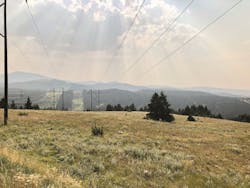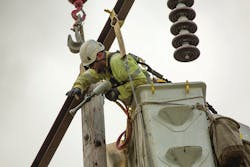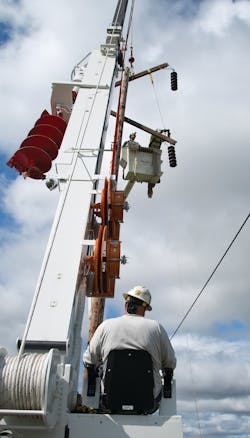The images of homes and communities consumed by wildfires in Southern California, U.S., in 2018 should serve as a stark wake-up call. The real possibility transmission infrastructure could be the source of a catastrophic fire poses unacceptable life-safety and financial risks to utilities and the people they serve. This is particularly true for those transmission providers in areas prone to the effects of a changing climate.
As wildfires captured the attention of the West in the fall of 2018, the Bonneville Power Administration (BPA) began performing a top-down review of its vegetation management program, all physical assets related to transmission, and the operations of its electric system to identify where and how the utility could further reduce the risk of potential fires across its expansive service territory.
BPA’s approach is driven by a simple equation: Fuel + Source of Ignition = Fire. In the absence of sufficient fuel or a source of ignition, the risk of a fire starting is low. BPA has been working proactively to reduce both factors.
Addressing Vegetation
With more than 15,000 circuit miles (24,140 circuit km) of high-voltage transmission across a service territory encompassing portions of eight states and roughly 300,000 sq miles (776,996 sq km) in the Northwest, BPA’s fire risk covers a wide geographical area. Historically, BPA has placed significant attention on vegetation management to reduce the risk of tree-related power outages. Its focus on wildfires has led the utility to recognize the vegetation management program also is essential to reduce the risk of wildfire. In addition to promoting low-growing plant communities, aggressive vegetation management practices can minimize fuel load in corridors and access roads.
Like all utilities on the West Coast, BPA must adhere to regulatory requirements on vegetation management as set by the North American Electric Reliability Corporation (NERC) and enforced by the Western Electricity Coordinating Council. However, BPA recognizes those requirements only set a minimum. The utility has achieved greater safety and reliability of operations while incurring less financial risk by going beyond what is required, to achieve what is reasonable and prudent for its service territory.
Its vegetation management crews clear brush in a 50-ft (15-m) diameter around all transmission structures and apply bare-ground herbicides by hand within 5 ft (1.5 m) of wood pole structures. BPA does not permit vegetation maintenance activities to leave debris that exceeds 18 inches (457 mm) in depth above the ground in its transmission corridors. Debris in excess of that 18-inch mark is lopped and scattered to maximize ground contact and minimize fire hazard. The vegetation clearance in BPA’s transmission corridors is so robust the corridors often are used for access to remote areas and as natural fire breaks by the firefighting community.
BPA’s integrated management approach to vegetation is not driven just by numbers, though. Timing is equally critical. BPA schedules its cutting and brush mowing activities during more temperate months of the year, avoiding the high temperatures and dry environment of the Northwest in the summer.
While critical for reliability and the safe operation of the electric grid, BPA’s vegetation management program does have an impact on natural areas. The utility has strived to improve conditions for pollinators and threatened species, like Oregon spotted frogs, in its transmission corridors. For example, the utility promotes low-growing grasses, hand mows and cuts nonnative vegetation, carefully applies spot herbicide treatments and takes extra precaution with equipment to avoid injuring the frogs, in particular.
In September 2019, BPA was recognized as an accredited Right-of-Way Steward by Right-of-Way Stewardship Council (ROWSC) at its annual Trees & Utilities Conference.
Analyzing Assets
Vegetation as fuel is one component of the fire equation. To address the source of ignition, BPA performed a deep analysis of its assets to understand how different types of equipment might fail and the direct consequences of a failure.
Drawing on existing historical data from yearly physical inspections by ground and air, BPA also increased its use of inspection methods, such as infrared and corona cameras with a focus on fire prevention. Using these inputs, BPA developed a programmatic approach to corrective work, based on the following:
- Criticality – the importance of the specific piece of equipment to overall safety and reliability of electric transmission
- Health – the condition of the specific piece of equipment that helps identify probability of failure
- Risk – a combination of criticality and health that determines the overall risk to transmission. If a piece of equipment is very critical but also very healthy or unhealthy but not very critical, it is a lower risk. A highly critical element that has low health is the highest risk.
One of the most illuminating pieces of information that emerged from this work was many of the equipment classes identified as having a risk of ignition related to failure were already in BPA’s maintenance workflow. In the past those projects often were pushed further down in the queue of maintenance work because they were not seen as critical.
However, after being viewed from the prism of a potential source of ignition, these backlogged projects dramatically rose in the queue because of their risk profile. In the spring of 2019, BPA began an intensive push to perform corrective work on equipment identified as having the greatest risk. As the summer progressed, more than 10,000 work hours were spent repairing, replacing or otherwise mitigating whole equipment populations across the service territory.
This is not an effort that can be addressed once and then considered complete. BPA’s understanding of risk constantly is evolving, as the utility becomes better informed. Moving forward, part of the utility’s asset management program will entail actively weighing fire risks when determining the priority of work to be completed on transmission equipment and facilities.
Understanding Operations
Addressing equipment failure is only one facet of the source of ignition in the fire equation. The utility recognizes other opportunities to reduce risk even further, both prior to and following equipment failure.
BPA has a weather and streamflow forecasting group that monitors conditions throughout the Columbia and Snake River basins. This group’s principal charge is to help inform the power services business line on hydrologic conditions to determine potential electrical output at 31 federal hydroelectric facilities. The weather and streamflow forecasting group provides transmission services with weather alerts during winter conditions that could impact the work of line crews and substation operators in the utility’s service territory.
That same skill and capability now is being used to provide real-time data to the transmission field services and transmission operations organizations, highlighting geographic areas currently experiencing an elevated fire risk based on existing conditions and current weather forecasts. BPA has changed its operational approach to responding to outages based on this weather information as well as the asset risk analysis.
When a transmission line relays out of service, BPA’s system is designed to automatically test or attempt to reclose a line and maintain service. Previously, if that initial automatic test failed to reclose the line successfully, its dispatch operators would manually test the line one more time. In many instances, whatever may have caused the line to relay out of service is a temporary occurrence, for example, a lightning strike or falling tree or limb that briefly contacted a line but is no longer impeding service.
If that line has components identified as a potential source of ignition or the line is located in an area where the environmental conditions suggest an elevated fire risk, BPA’s dispatch operators will not test the line until the utility can get a line crew on scene to inspect the transmission corridor visually and ensure it is safe to attempt to reenergize the line. While it reduces fire risk, this new protocol has resulted in longer outages, particularly when the affected transmission lines are located in remote and hard-to-access areas.
BPA believes the inconvenience of a longer outage is well worth the improved safety of its employees and the public. One aspect of operations the utility has not used yet is the practice of deenergizing transmission lines as a preventive measure to address potential wildfires. This practice has garnered significant media coverage and intense public interest in recent months. BPA does not preclude the possibility of deenergizing lines if conditions indicate a clear and imminent threat to life, safety or system reliability.
Collaborative Learning
A critical component of BPA’s understanding of fire risk, and its resultant strategies to reduce that risk, is its collaboration and shared learning with other utilities and subject matter experts. BPA actively seeks input from others who share its perspective that regulatory requirements are a starting point—not the finish line.
BPA has found many of those voices within the North American Transmission Forum, a consortium of utilities across the U.S. that share best practices to improve reliability and safety across the industry. BPA also participates in state and regional wildfire forums and panels, which offer the utility an opportunity to engage in robust discussions of risks and mitigation steps. Equally as important, BPA has connected at a leadership level with other major utilities throughout the Northwest to continue those conversations.
These resources enable BPA to adapt its operational and asset management protocols to reduce the risks of fire associated with the utility’s equipment and actions. Since 1938, the utility fortunately has not been the source of or a contributor to a wildfire. By becoming better informed on fire risks and minimizing fuel load and sources of ignition in its transmission corridors, BPA is working actively to prevent wildfires for the benefit of its ratepayers and the people of the Northwest.
About the Author
Michelle Cathcart
Michelle Cathcart is vice president of transmission system operations for the Bonneville Power Administration. She oversees the safe, reliable, and open-access operation and dispatch of the utility’s high-voltage transmission system and interconnected generation. She previously served as director of strategy and organizational performance at Peak Reliability.
Mike Miller
Mike Miller, P.E., works for Powerserve Technologies, Inc with 20 years of experience in designing and implementing protection and control schemes. He has a BSEE from the University of Central Florida, is a professional engineer in the State of Florida, and a member of IEEE.




